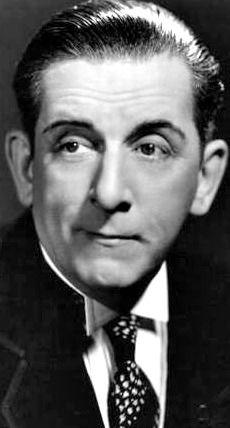Edward Everett Horton Death
Edward passed away on September 29, 1970 at the age of 84 in Encino, CA. Edward's cause of death was cancer.
When did Edward Everett Horton die?
September 29, 1970How did Edward Everett Horton die? What was the cause of death?
CancerHow old was Edward Everett Horton when died?
84Where did Edward Everett Horton die? What was the location of death?
Encino, CA
Edward Everett Horton Birthday and Date of Death
Edward Everett Horton was born on March 18, 1886 and died on September 29, 1970. Edward was 84 years old at the time of death.
Birthday: March 18, 1886
Date of Death: September 29, 1970
Age at Death: 84
Edward Everett Horton - Biography
Edward Everett HortonActive - 1922 - 1970 | Born - Mar 18, 1886 in Brooklyn, New York City, NY | Died - Sep 29, 1970 in San Fernando Valley, CA | Genres - Comedy, Romance, MusicalBiography by Bruce Eder Few actors were more beloved of audiences across multiple generations -- and from more different fields of entertainment -- than Edward Everett Horton. For almost 70 years, his work delighted theatergoers on two coasts (and a lot of the real estate in between) and movie audiences, first in the silents and then in the talkies, where he quickly became a familiar supporting player and then a second lead, often essaying comically nervous "fuddy-duddy" parts, and transcended the seeming limitations of character acting to rival most of the leading men around him in popularity; he subsequently moved into television, both as an actor and narrator, and gained a whole new fandom for his work as the storyteller in the animated series "Fractured Fairy Tales."Edward Everett Horton was born in Brooklyn, NY, in 1886 -- when it was a separate city from New York City -- the son of Edward Everett Horton and Isabella Diack Horton. His grandfather was Edward Everett Hale, the author of the story The Man Without a Country. He attended Boys High School and later studied at the Brooklyn Polytechnic Institute and at Oberlin College in Ohio, and Columbia University in Manhattan. His path to graduation was thwarted when he joined the university's drama club -- despite his 6'2" build, his first role had him cast as a woman. He never did graduate from Columbia, but he embarked on a performing career that was to keep him busy for more than six decades. In those days, he also sang -- in a baritone -- and joined the Staten Island-based Dempsey Light Opera Company for productions of Michael Balfe's The Bohemian Girl and Gilbert & Sullivan's The Mikado. His singing brought him to the Broadway stage as a chorus member, and he subsequently spent three years with the Louis Mann company honing his acting skills while playing in stock -- Horton made his professional acting debut in 1908 with a walk-on role in The Man Who Stood Still. By 1911, he was working steadily and regularly, and often delighting audiences with his comedic talents, and remained with the Mann company for another two years. He was a leading man in the Crescent Theatre stock company, based in Brooklyn, and spent the remainder of the teens playing leading roles in theater companies across the United States, eventually basing himself in Los Angeles.Horton entered movies in 1918, and became well known to screen audiences with his performance in the 1923 version of Ruggles of Red Gap. He was identified almost entirely with comedic work after that, and by the end of the '20s had starring roles in a string of comedic shorts. It was after the advent of sound, however, that he fully hit his stride on the big screen. Horton's first talking feature was The Front Page (1931), directed by Lewis Milestone, based on the hit play by Ben Hecht and Charles MacArthur, in which he played fidgety reporter Roy Bensinger. Starting in the early '20s, Horton based most of his stage work on the West Coast, producing as well as acting. He leased the Majestic Theater in Los Angeles and found success with works such as The Nervous Wreck, in which he worked with Franklin Pangborn, a character actor who would also -- like Horton -- specialize in nervous, fidgety roles (though Pangborn, unlike Horton, never rose beyond character actor and supporting player status in features). In 1932, he leased the Hollywood Playhouse, which he subsequently operated for a season starring in Benn Wolfe Levy's Springtime for Henry, in which he performed more than 3000 times, making enough money from that play alone to buy his summer home in the Adirondacks.Horton fit in his movie work in between productions of Springtime for Henry (which was filmed in 1934, without Horton), and was always in demand. Amid his many roles over the ensuing decade, Horton worked in a half-dozen of the Fred Astaire/Ginger Rogers musicals at RKO. His other notable roles onscreen during the 1930s included a portrayal of The Mad Hatter in the 1933 Alice in Wonderland, and a neurotic paleontologist (who first appears disguised as a woman) in Frank Capra's Lost Horizon (1937). He worked in at least six movies a year from the early '30s through the end of the 1940s, and there were occasional serious variations in his roles -- Horton played an unusually forceful part in Douglas Sirk's Summer Storm (1944), and he delivered a comedic tour de force (highlighted by a delightful scene with Carmen Miranda) in Busby Berkeley's The Gang's All Here (1943).Horton kept busy for more than 60 years, and not just in acting -- along with his brother George he bought up property in the San Fernando Valley from the 1920s onward, eventually assembling Beleigh Acres, a 23-acre development where he lived with his mother (who passed away at age 102). His hobbies included antiques, and at the time of his death in 1970, he had a collection with an estimated value of a half million dollars. He was busy on television throughout the 1950s and '60s, not only in onscreen work but also voice-overs for commercials, and he even hosted the Westminster Kennel Club dog show at Madison Square Garden. Horton was a regular cast member on the comedy Western series F Troop, playing Roaring Chicken (also referred to as Running Chicken), the Hekawi indian tribe medicine man. But his most enduring work from the 1960s was as the narrator of "Fractured Fairy Tales," the Jay Ward-produced co-feature to Rocky & Bullwinkle, in which he was prominently billed in the opening credits of every episode. That engagement endeared him to millions of baby boomers and their parents, and his work in those cartoons continues to gain Horton new fans four decades after his death.He grew frail in appearance during the 1960s, and was not averse to playing off of that reality on series such as Dennis the Menace, where he did a guest-star spot in one episode as Uncle Ned, a health-food and physical-culture fanatic. Horton never married, and shared a home later in life with his sister, Hannabelle Grant. He was hospitalized weeks before his death from cancer in September 1970, and was so busy that during that hospitalization he showed up as a guest star in two episodes of the sitcom The Governor and J.J., His final big-screen appearance was in the Bud Yorkin/Norman Lear comedy Cold Turkey, which wasn't released until the following year.








